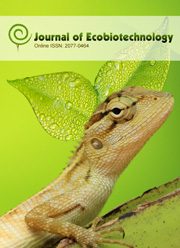Diversity of leaf spot pathogen associated with vegetable from Chhatrapati Sambhajinagar, Maharashtra
DOI:
https://doi.org/10.25081/jebt.2025.v17.9556Keywords:
Vegetable, Leaf spot, ITS, Genetic DiversityAbstract
Vegetables are important constituents of Indian agriculture and nutritional security due to their short duration, high yield, nutritional richness, economic viability and ability to generate on-farm and off-farm employment. The fungal diseases are serious threats to vegetable crop production. The leaf spot infection can result in chlorosis, defoliation, and a decline in the photosynthetic capacity of plant, potentially reducing fruit yield by up to 100% loss. During this investigation the genetic diversity of leaf spot pathogen, the infected samples were collected from different localities of Chhatrapati Sambhajinagar in Kharif and Rabi season of 2023-2024. It was found that the five different leaf spot pathogens via; Cladosporium cladosporioides-1, Cladosporium cladosporioides-2, Curvularia crepinii, Curvularia geniculata and Macrophomina pseudophaseolina from different localities were shows the morphological as well as genetic diversity among each other. The genetic variability in the leaf spot pathogen isolates may be due to difference in geographical and environmental conditions. The ITS primer is used to analysis, it was found diversity among leaf spot pathogen isolates at molecular characterization. The phylogenetic analysis using ITS Primer showed the grouping of leaf spot pathogen isolates strictly according to their cultural characteristics and degree of pathogenicity and not the geographical origin.
Downloads
References
Abd-Elsalam, K. A., Aly, I. N., Abdel-Satar, M. A., Khalil, M. S., & Verreet, J. A. (2003). PCR identification of Fusarium genus based on nuclear ribosomal-DNA sequence data. African Journal of Biotechnology, 2(4), 82-85. https://doi.org/10.5897/AJB2003.000-1016
Back, C.-G., Lee, S.-Y., Kang, I.-K., Yoon, T.-M., & Jung, H.-Y. (2015). Occurrence and analysis of apple blotch-like symptoms on apple leaves. Horticultural Science and Technology, 2015, 429-434. https://doi.org/10.7235/hort.2015.14179
Barbedo, J. G. A. (2016). A review on the main challenges in automatic plant disease identification based on visible range images. Biosystems Engineering, 144, 52-60. https://doi.org/10.1016/j.biosystemseng.2016.01.017
Chakrabarty, T., Sarker, U., Hasan, M., & Rahman, M. M. (2018). Variability in mineral compositions, yield and yield contributing traits of stem amaranth (Amaranthus lividus). Genetika, 50(3), 995-1010. https://doi.org/10.2298/GENSR1803995C
Cheng, Q., Chen, J., & Zhao, L. (2021). Draft genome sequence of Marssonina coronaria causal agent of apple blotch and comparisons with the Marssonina brunnea and Marssonina rosae genomes. Plos One, 16(2), e0246666. https://doi.org/10.1371/journal.pone.0246666
da Silva, B. V., Barreira, J. C. M., & Oliveira, M. B. P. P. (2016). Natural phytochemicals and probiotics as bioactive ingredients for functional foods: extraction, biochemistry and protected-delivery technologies. Trends in Food Science & Technology, 50, 144-158. https://doi.org/10.1016/j.tifs.2015.12.007
Ellis, M. B. (1971). Dematiaceous Hyphomycetes. Minnesota University, Kew: Commonwealth Mycological Institute.
Forni, C., Facchiano, F., Bartoli, M., Pieretti, S., Facchiano, A., D'Arcangelo, D., Norelli, S., Valle, G., Nisini, R., Beninati, S., Tabolacci, C., & Jadeja, R. N. (2019). Beneficial role of phytochemicals on oxidative stress and age-related diseases. BioMed Research International, 23(2), 33-42. https://doi.org/10.1155/2019/8748253
Hansen, H. N. (1926). A simple method of obtaining single-spore cultures. Science, 64(1659), 384.
Lee, D.-H., Back, C.-G., Win, N. K. K., Choi, K.-H., Kim, K.-M., Kang, I.-K., Choi, C., Yoon, T.-M., Uhm, J. Y., & Jung, H.-Y. (2011). Biological characterization of Marssonina coronaria associated with apple blotch disease. Microbiology, 39(3), 200-205. https://doi.org/10.5941/MYCO.2011.39.3.200
Liang, X., Zhang, R., Gleason, M. L., & Sun, G. (2022). Sustainable apple disease management in China: challenges and future directions for a transforming industry. Plant Disease, 106(3), 786-799. https://doi.org/10.1094/PDIS-06-21-1190-FE
Mukadam, D. S., Patil, M. S., Chavan, A. M., & Patil, A. R. (2006). The Illustrations of Fungi. Aurangabad, India: Saraswati Printing Press.
Nizamani, M. M., Zhang, Q., Muhae-Ud-Din, G., & Wang, Y. (2023). High-throughput sequencing in plant disease management: a comprehensive review of benefits, challenges, and future perspectives. Phytopathology Research, 5, 44. https://doi.org/10.1186/s42483-023-00199-5
Rangaswami, G. (1972). Disease of crop plants in India. New Delhi, India: Prentice Hall.
Sarker, U., & Oba, S. (2018a). Response of nutrients, minerals, antioxidant leaf pigments, vitamins, polyphenol, flavonoid and antioxidant activity in selected vegetable Amaranth under four soil water content. Food Chemistry, 252, 72-83. https://doi.org/10.1016/j.foodchem.2018.01.097
Sarker, U., & Oba, S. (2018b). Drought stress effects on growth, Ros markers, compatible solutes, phenolics, flavonoids, and antioxidant activity in Amaranthus tricolor. Applied Biochemistry and Biotechnology, 186(4), 999-1016. https://doi.org/10.1007/s12010-018-2784-5
Sarker, U., Islam, M. T., Rabbani, M. G., & Oba, S. (2014). Genotypic variability for nutrient, antioxidant, yield and yield contributing traits in vegetable Amaranth. Journal of Food, Agriculture & Environment, 12(3&4), 168-174.
Sarker, U., Islam, M. T., Rabbani, M. G., & Oba, S. (2015a). Variability, heritability and genetic association in vegetable amaranth (Amaranthus tricolor). Spanish Journal of Agricultural Research, 13(2), 1-8. https://doi.org/10.5424/sjar/2015132-6843
Sarker, U., Islam, M. T., Rabbani, M. G., & Oba, S. (2015b). Genotype variability in composition of antioxidant vitamins and minerals in vegetable Amaranth. Genetika, 47(1), 85-96. https://doi.org/10.2298/GENSR1501085S
Sarker, U., Islam, M. T., Rabbani, M. G., & Oba, S. (2016). Genetic variation and interrelationship among antioxidant, quality and agronomic traits in vegetable Amaranth. Turkish Journal of Agriculture and Forestry, 40(4), 526-535. https://doi.org/10.3906/tar-1405-83
Sarker, U., Islam, M. T., Rabbani, M. G., & Oba, S. (2017). Genotypic diversity in vegetable Amaranth for antioxidant, nutrient and agronomic traits. Indian Journal of Genetics and Plant Breeding, 77(1), 173-176. https://doi.org/10.5958/0975-6906.2017.00025.6
Sarker, U., Islam, M. T., Rabbani, M. G., & Oba, S. (2018a). Variability in total antioxidant capacity, antioxidant leaf pigments and foliage yield of vegetable Amaranth. Journal of Integrative Agriculture, 17(5), 1145-1153. https://doi.org/10.1016/S2095-3119(17)61778-7
Sarker, U., Islam, M. T., Rabbani, M. G., & Oba, S. (2018b). Phenotypic divergence in vegetable Amaranth for total antioxidant capacity, antioxidant profile, dietary fiber, nutritional and agronomic traits. Acta Agriculturae Scandinavica, Section B - Soil & Plant Science, 68, 67-76. https://doi.org/10.1080/09064710.2017.1367029
Sarker, U., M.T., Islam, M.G., Rabbani, S. Oba., (2018c). Antioxidant leaf pigments and variability in vegetable Amaranth. Genetika, 50(1), 209-220. https://doi.org/10.2298/GENSR1801209S
Sastrahidayat, I. R., & Nirwanto, H., (2016). Marssonina leaf blotch on the apple orchard in Batu, Indonesia. Agrivita Journal of Agricultural Science, 38(2), 204-212. https://doi.org/10.17503/agrivita.v38i2.635
Shirsath, L. P., Patil, S. P., & Patil, U. K. (2018). Incidence of leaf spot disease on cotton caused by Curvularia verruculosa and role of its hydrolytic enzymes in pathogenesis. Physiology and Molecular Biology of Plants, 24(4), 711-714. https://doi.org/10.1007/s12298-018-0557-9
Singh, V., & Misra, A. K. (2017). Detection of plant leaf diseases using image segmentation and soft computing techniques. Information Processing in Agriculture, 4(1), 41-49. https://doi.org/10.1016/j.inpa.2016.10.005
Srivastava, J. N., Singh, A. K., & Sharma, R. K. (2020). Diseases of apples and their management. In G. Chand, M. N. Akhtar & S. Kumar (Eds.), Diseases of Fruits and Vegetable Crops (pp. 19-39) New York, US: Apple Academic Press. https://doi.org/10.1201/9780429322181-3
Tamura, K., Stecher, G., & Kumar, S. (2021). MEGA11: Molecular Evolutionary Genetics Analysis Version 11. Molecular Biology and Evolution, 38(7), 3022-3027. https://doi.org/10.1093/molbev/msab120
Tripathi, A. N., Krishna, H., Singh, N., Roy, S., & Singh, J. (2019). Status and Prospects of Bio agents for Biological Control of Plant Diseases (Eds.). Advanced Vegetable Production Technologies for Enhancing Productivity and Nutritional Security (pp. 239-258) ICAR-IIVR Training Manual No. 86.
White, T. J., Bruns, T. D., Lee, S. B., & Taylor, J. W. (1990). Amplification and Direct Sequencing of Fungal Ribosomal RNA Genes for Phylogenetics. In M. A. Innis, D. H. Gelfand, J. J. Sninsky & T. J. White (Eds.,) PCR Protocols: A Guide to Methods and Applications (pp. 315-322) New York, US: Academic Press. https://doi.org/10.1016/B978-0-12-372180-8.50042-1
Published
How to Cite
Issue
Section
Copyright (c) 2025 Radha V. Ghuge, Sulochana R. Rathod, Ajay S. Zinjade

This work is licensed under a Creative Commons Attribution-NonCommercial 4.0 International License.



 .
.